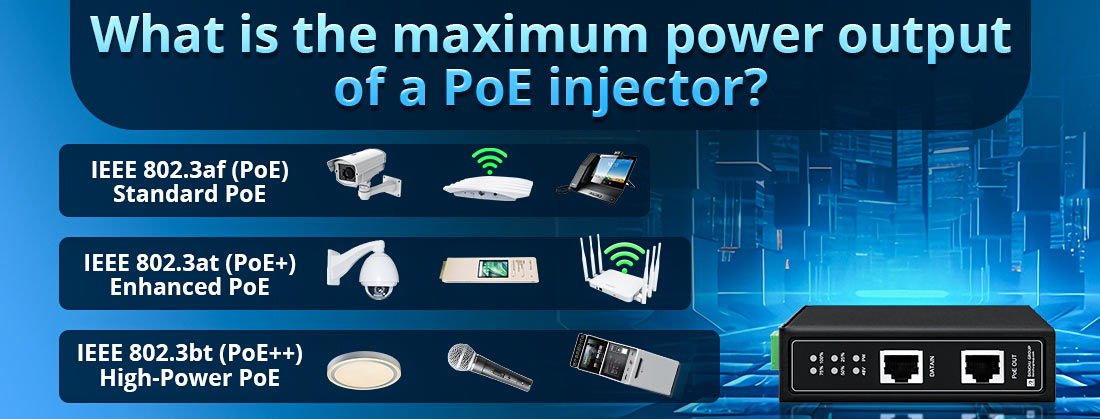
Максимальная выходная мощность PoE-инжектора
Максимальная выходная мощность PoE-инжектора означает количество электроэнергии, которую он может передать питаемому устройству (PD) по кабелю Ethernet. Это питание необходимо для обеспечения правильной работы сетевых устройств, которым требуются как данные, так и питание (например, IP-камеры, точки беспроводного доступа или телефоны VoIP), без необходимости использования отдельных кабелей питания.
Инжекторы PoE соответствуют стандартам IEEE для подачи питания, а максимальная выходная мощность зависит от конкретного используемого стандарта PoE. Вот подробная разбивка:
1. IEEE 802.3af (PoE) – 15,4 Вт на порт
Максимальная выходная мощность на PSE (оборудование источника питания):
--- 15,4 Вт — это максимальная мощность, PoE-инжектор (PSE) может подавать питание на питаемое устройство (PD).
--- Мощность, подаваемая на PD: фактическая мощность, которая достигает питаемого устройства, обычно составляет около 12,95 Вт из-за потерь в кабеле Ethernet.
Технические характеристики:
--- Напряжение: от 44 В до 57 В постоянного тока
--- Ток: максимум 350 мА
--- Мощность, подаваемая на PD: 12,95 Вт (с учетом потерь по кабелю Ethernet)
--- Общие случаи использования:
--- Базовые IP-камеры
--- VoIP-телефоны
--- Простые точки беспроводного доступа (WAP)
--- Устройства Интернета вещей с низким энергопотреблением
--- Маленькие датчики
2. IEEE 802.3at (PoE+) – 30 Вт на порт
Максимальная выходная мощность на PSE (оборудование источника питания):
--- 30 Вт — это максимальная мощность, которую PoE-инжектор (совместимый со стандартом IEEE 802.3at) может передать устройству.
--- Мощность, подаваемая на PD: обычно около 25,5 Вт с учетом потерь.
Технические характеристики:
--- Напряжение: от 50 В до 57 В постоянного тока
--- Ток: максимум 600 мА
--- Мощность, подаваемая на PD: 25,5 Вт (с учетом потерь по кабелю Ethernet)
Общие случаи использования:
--- PTZ-камеры (Pan-Tilt-Zoom)
--- Усовершенствованные точки беспроводного доступа (WAP)
--- Телефоны VoIP с поддержкой видео
--- Цифровые вывески
--- Маленькие сетевые коммутаторы
3. ИЭЭЭ 802.3бт (PoE++ или 4PPoE) – от 60 до 100 Вт на порт
IEEE 802.3bt — новейший стандарт, обеспечивающий два типа выходной мощности:
--- Тип 3 (PoE++) – 60 Вт на порт
Максимальная выходная мощность на PSE: 60 Вт на порт — это максимальная мощность, которую может передать инжектор PoE.
--- Мощность, подаваемая на PD: обычно около 51 Вт (из-за потери мощности).
Технические характеристики:
--- Напряжение: от 50 В до 57 В постоянного тока
--- Ток: до 960 мА
--- Мощность, подаваемая на PD: 51 Вт (с учетом потерь по кабелю Ethernet)
Общие случаи использования:
--- Высокопроизводительные точки беспроводного доступа (Wi-Fi 6)
--- PTZ-камеры с обогревателями/вентиляторами
--- Цифровые вывески (дисплеи большего размера)
--- Светодиодные системы освещения
--- Умные устройства Интернета вещей
--- Тип 4 (PoE++ или 4PPoE) – 100 Вт на порт
Максимальная выходная мощность на PSE: 100 Вт на порт — это максимальная мощность, которую может обеспечить инжектор PoE.
Мощность, подаваемая на PD: обычно около 71 Вт (с учетом потерь).
Технические характеристики:
--- Напряжение: от 50 В до 57 В постоянного тока
--- Ток: до 1,5 А на пару (поскольку тип 4 использует все четыре пары кабеля Ethernet)
--- Мощность, подаваемая на PD: 71 Вт (с учетом потерь по кабелю Ethernet)
Общие случаи использования:
--- Точки доступа Wi-Fi 6E (следующее поколение беспроводной технологии)
--- Большие цифровые вывески
--- Мощные устройства, такие как современные IP-камеры (включая PTZ)
--- Периферийные вычислительные устройства
--- Светодиодные системы освещения для больших площадей
4. Пассивное PoE
Максимальная выходная мощность на PSE:
--- Максимальная выходная мощность пассивного PoE не стандартизирована. Обычно оно находится в диапазоне 12 В, 24 В или 48 В, в зависимости от конструкции и производителя форсунки.
--- В отличие от стандартов IEEE 802.3, пассивный PoE не использует согласование мощности и обеспечивает фиксированное напряжение. Максимальная выдаваемая мощность полностью зависит от конкретной модели.
Общие случаи использования:
--- Устройства Ubiquiti Networks, такие как беспроводные радиомодули или точки доступа.
--- Собственные устройства, для которых требуется определенное напряжение (например, некоторое устаревшее сетевое оборудование).
Сравнение выходной мощности:
| Стандартный | Максимальная выходная мощность (PSE) | Электроэнергия подается на PD | Диапазон напряжения (постоянный ток) | Общие случаи использования |
| 802.3af (PoE) | 15,4 Вт | 12,95 Вт | 44 В – 57 В | VoIP-телефоны, базовые IP-камеры, небольшие WAP-сети. |
| 802.3at (PoE+) | 30 Вт | 25,5 Вт | 50 В - 57 В | PTZ-камеры, расширенные WAP-сети, цифровые вывески |
| 802.3bt (PoE++) | 60 Вт (Тип 3), 100 Вт (Тип 4) | 51 Вт (Тип 3), 71 Вт (Тип 4) | 50 В - 57 В | Точки доступа Wi-Fi 6, PTZ-камеры, светодиодное освещение |
| Пассивное PoE | Варьируется (обычно 12 В, 24 В, 48 В) | Варьируется | Фиксированное (например, 12 В, 24 В, 48 В) | Собственные устройства, устаревшее оборудование |
Ключевые выводы:
--- IEEE 802.3af (PoE) идеально подходит для устройств с низким энергопотреблением, таких как IP-камеры и телефоны VoIP, с максимальной выходной мощностью 15,4 Вт.
--- IEEE 802.3at (PoE+) поддерживает более высокие требования к мощности, до 30 Вт, что делает его пригодным для PTZ-камер и расширенных точек доступа.
--- IEEE 802.3bt (PoE++ или 4PPoE) предлагает выходы типа 3 (60 Вт) и типа 4 (100 Вт), способные питать устройства с высоким спросом, такие как точки доступа Wi-Fi 6 и большие дисплеи цифровых вывесок.
--- Пассивное PoE обеспечивает различные уровни мощности в зависимости от производителя, без стандартизированного напряжения или согласования мощности, что часто используется для проприетарных устройств.
Выходная мощность PoE-инжектора определяет, какие устройства он может питать, поэтому крайне важно выбрать инжектор, который соответствует требованиям к питанию устройств в вашей сети. Для устройств высокой мощности необходимы инжекторы PoE++ (802.3bt), тогда как устройствам с меньшим энергопотреблением могут потребоваться только стандартные инжекторы PoE (802.3af).